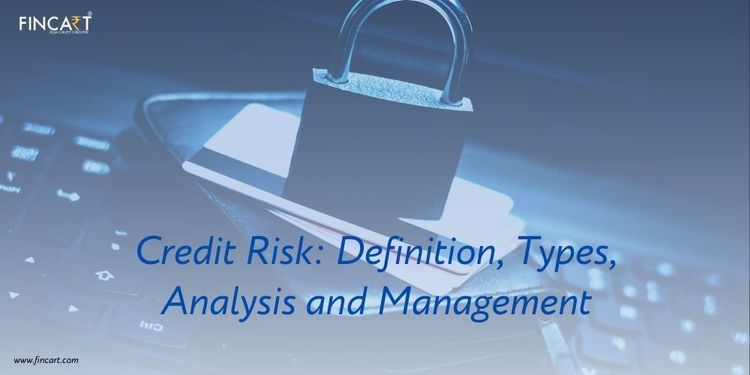Table of Contents
ToggleCredit risk is one of the financial world’s most important and challenging aspects. It affects lenders, borrowers, investors, and regulators alike. It can have significant implications for the stability and profitability of financial institutions and markets. But what exactly is credit risk? How is it measured and managed? What are the impacts and strategies of credit risk management? We will run through a few case studies with examples to dig deeper into the concept of credit risk. And we will also learn about the 5 Cs of credit risk. In this article, we will discuss every aspect in detail.
What is Credit risk?
Credit risk is the likelihood of losing money due to a borrower’s failure to repay a loan or meet contractual obligations. It is a method of determining a borrower’s or an investment’s creditworthiness. It impacts the lender’s or investor’s cash flows and costs. Credit risk management is the process of assessing, measuring, and controlling the credit risk of a lender or an investor. It involves using various tools and strategies, such as credit scoring, credit rating, diversification, collateral, covenants, and hedging, to reduce the exposure and impact of credit risk. The proactive integration of risk management practices is instrumental in ensuring the overall health and stability of financial endeavors
Types of credit risk
Credit risk can affect anyone who deals with credit, from banks and corporations to individuals and governments. But not all credit risks are the same. Credit risk varies with the nature and source of the probable loss. Knowing the types of credit risk can help you understand, measure, and manage them better. We will here discuss some major types of credit risk banks or other lending entities face.
1. Default Risk
Default risk is one of the most basic and obvious types of credit risk. It is the risk that any Bank or lending institution takes that the borrower may not pay back their debt in full or on time. For example, if you lend money to a friend and they don’t repay you, you face default risk. Similarly, if you buy a bond and the issuer doesn’t pay the interest or principal, you face default risk.
Default risk can affect any kind of credit transaction, from loans and mortgages to bonds and derivatives. The higher the default risk, the higher the interest rate or yield that lenders or investors demand. Default risk can be influenced by many factors, such as the borrower’s credit history, income, assets, liabilities, business conditions, economic environment, and legal protection.
2. Concentration Risk
Concentration risk is the risk of having too much exposure to a single borrower, industry, sector, region, or asset class. For example, if a bank lends most of its money to one company or industry, it faces concentration risk. Similarly, if an investor puts most of their portfolio in one type of bond or currency, they face concentration risk. Concentration risk can increase the impact of default risk or other types of credit risk.
If a borrower or a market segment experiences financial distress or collapse, it can cause significant losses for the lender or investor who has concentrated exposure to them. Therefore, diversification is a key strategy to reduce concentration risk.
3. Country Risk
Next on the list of types of credit risk is country risk. Country risk is the risk of loss arising from a sovereign state’s actions or events. For example, if a country faces any political instability and makes key changes in its economic policies, like exchange-rate changes or technological advancement, it can affect the ability or willingness of its borrowers to repay their debts. Any lender has to consider hundreds of factors, starting from the existing tax regime to the country’s political instabilities, before arriving at a definite risk number. The higher the score of country risk, the lower the risk of money laundering, indicating smoother business transactions.
4. Downgrade Risk
Downgrade risk is one of the types of credit risk that the Bank or lender takes when the borrower’s credit rating is lowered by a rating agency. For example, if a company’s financial performance deteriorates or its debt level increases, it may be downgraded by Moody’s or Fitch. Similarly, if a country’s fiscal situation worsens or its political stability declines, it may be downgraded by Standard & Poor’s or DBRS.
Downgrade risk can affect the market value and liquidity of a borrower’s debt instruments. A downgrade can increase the borrowing cost and refinancing risk for the borrower. It can also reduce the demand and price for the borrower’s bonds or loans in the secondary market. Downgrade risk is the credit risk that can trigger contractual clauses that require additional collateral or early repayment.
5. Institutional Risk
Institutional risk is the risk of loss arising from the failure or misconduct of a financial institution. Let’s take an example to understand this credit risk. Say, if an insurance company is declared insolvent or fraudulent, it may not be able to honor the insurance claims or maturity benefits to its policyholders.
Institutional risk can affect both direct and indirect stakeholders of a financial institution. Direct stakeholders include depositors, creditors, counterparties, shareholders, employees, and regulators. Indirect stakeholders include customers, suppliers, competitors, investors, and the general public. Institutional risk can be influenced by many factors, such as the institution’s capital adequacy, asset quality, liquidity management, governance structure, internal controls, compliance culture, and reputation.
We have discussed some of the main types of credit risk that you must know about. This will help you make better-informed credit decisions while protecting you from potential losses.
Also Read: Liquidity Risk – What Is It & Its Types?
Assessing and managing credit risk
Credit Risk is a potential threat to the financial health of any lending institution. If credit risk management is not done skilfully, it affects not only the profitability, liquidity, and solvency of a bank but also its reputation and regulatory compliance.
Therefore, assessing and managing credit risk is a crucial task for banks. It involves identifying, measuring, monitoring, and controlling the credit exposures of different borrowers and portfolios. It also involves designing and implementing effective credit policies and procedures that align with the bank’s strategic objectives and risk appetite.
Here are some of the key steps and techniques involved in assessing and managing credit risk:
1. Credit Risk Analysis
Credit Risk analysis simply means evaluating the creditworthiness of a borrower based on multiple financial metrics like their paying capacity, their reputation, and other relevant factors. Credit Risk analysis helps banks to determine the probability of default (PD) of a borrower, which is the likelihood that they will fail to meet their contractual obligations.
Credit Risk analysis can be performed using various methods and tools, such as financial ratios, cash flow analysis, credit scoring models, rating agencies’ reports, and qualitative assessments. Credit analysis can be done at different levels of granularity, such as for individual borrowers, segments, or portfolios.
2. Credit Rating
A credit rating is the outcome of credit analysis that assigns a numerical or alphabetical score to a borrower or a debt instrument based on their credit risk. It helps to assess credit risk by putting borrowers into three different risk baskets, such as low risk, medium risk, or high risk.
Credit rating also helps banks determine the loss-given default (LGD) of a borrower or a debt instrument, which is the percentage of exposure that will not be recovered in the event of default. Credit ratings can be done internally by the bank’s credit analysts or externally by independent rating agencies.
3. Credit Pricing
Credit pricing is one of the most crucial factors in credit risk assessment. Simply, credit pricing is the premium or extra fees on top of a reference/ Base rate that a Bank or lending institution takes to compensate for the assumed credit risk.
Credit pricing aims to ensure that the bank earns an adequate return on its capital while covering its expected losses and operational costs. Credit pricing can be done using various methods and models, such as risk-adjusted return on capital (RAROC), economic value added (EVA), or loan pricing software.
4. Credit Risk Monitoring
Credit Risk monitoring is the process of tracking and reviewing the performance and behavior of borrowers and debt instruments over time. Credit monitoring helps banks to detect any changes or signs of deterioration in their credit quality and take timely actions to prevent or mitigate losses.
Credit Risk monitoring can be done using various indicators and tools, such as repayment history, financial statements, covenants compliance, early warning signals, stress testing, and portfolio reports. The frequency of monitoring may be at fixed intervals or on an ad-hoc basis, depending on the nature and extent of credit risk.
5. Credit Control
Credit control is the process of assessing and managing inherent credit risk. It involves the implementation of the credit policies and procedures that govern the lending activities of a bank. Credit control helps banks to ensure that their credit exposures are within their risk appetite and regulatory limits and that their credit processes are consistent and efficient.
Credit control can be done using various mechanisms and tools, such as credit approval authority, credit limits, collateral requirements, loan loss provisioning, loan review function, audit function, and corrective actions.
Credit control can be done at different levels of authority and responsibility within the bank’s organizational structure.
Impact of credit risk on financial institutions
For example, credit risk can reduce the interest income and fee income that financial institutions earn from their borrowers. It can also increase the provision expenses and write-off expenses that financial institutions incur for their non-performing loans.
Moreover, credit risk can impair the quality and value of the assets that financial institutions hold as collateral or investments. It can also increase the liabilities and funding costs that financial institutions face from their creditors or depositors. Furthermore, credit risk can erode the capital and reserves that financial institutions need to absorb losses and meet regulatory requirements.
Therefore, credit risk can hurt the profitability, liquidity, and solvency of financial institutions. It can also affect their reputation and regulatory compliance. Hence, assessing and managing credit risk is vital for financial institutions.
Also Read: Understanding Budgeting In Financial Management
Strategies for credit risk management
We will now discuss some of the major strategies of credit risk management. By applying them appropriately, financial institutions can enhance their credit quality and profitability while reducing their credit losses and risks.
Diversification
Diversification is the strategy of spreading credit exposures across different borrowers, industries, sectors, regions, or asset classes. Diversification reduces the concentration risk, which is the risk of having too much exposure to a single borrower or a market segment. Diversification can be achieved by following some principles, such as:
1. Avoiding over-reliance on a few large or related borrowers
2. Seeking exposure to a variety of industries and sectors with different business cycles and growth prospects
3. Expanding into different geographic markets with different economic and political conditions
Mitigation
Mitigation is the strategy of reducing credit risk or transferring it to another party. Mitigation reduces the loss-given default (LGD), which is the percentage of exposure that will not be recovered in the event of default.
Mitigation can be achieved by using some techniques, such as:
1. Obtaining collateral or guarantees from the borrowers or third parties
2. Selling or securitizing the credit exposures to other investors
3. Buying credit derivatives or insurance to hedge against credit losses
Pricing
Pricing is the strategy of setting the appropriate interest rate or fee for extending credit. Pricing aims to ensure that the expected return on capital is commensurate with the expected loss and operational costs.
Pricing can be done by using some methods and models, such as:
1. Risk-adjusted return on capital (RAROC), which calculates the return on capital after deducting the expected loss and capital charge
2. Economic value added (EVA), which calculates the value added by lending after deducting the cost of capital
3. Loan pricing software, which incorporates various inputs and assumptions to determine the optimal interest rate or fee
Case studies and examples
Steinhoff International: This is an example of how governance issues can lead to a massive default risk for a multinational retailer. In 2017, Steinhoff revealed accounting irregularities that overstated its profits and assets by billions of euros.
As a result, its share price and bond prices plummeted, its credit ratings were downgraded to junk status, and it faced lawsuits and investigations from creditors, regulators, and shareholders.
Coca-Cola Amatil: This is an example of how social issues can affect the credit quality of a beverage company. Coca-Cola Amatil (CCL) faced headwinds from structural shifts in consumer demand for healthier options and regulatory risks relating to sugar consumption. These factors negatively impacted its profitability and cash flow generation. As a result, its credit spreads widened, and its credit ratings were put on a negative outlook by rating agencies.
The 5 Cs of credit
The 5 Cs of credit are a set of criteria that lenders use to evaluate the creditworthiness of a borrower. The 5 Cs of credit are:
1. Character: This refers to the borrower’s reputation, integrity, and willingness to repay their debt. Lenders look at the borrower’s credit history, references, and personal background to assess their character.
2. Capacity: This refers to the borrower’s ability to repay their debt based on their income, expenses, and existing debt obligations. Lenders look at the borrower’s cash flow, debt-to-income ratio, and debt-service coverage ratio to assess their capacity
3. Capital: This refers to the borrower’s net worth, assets, and equity that can be used as collateral or cushion in case of default. Lenders look at the borrower’s balance sheet, savings, and investments to assess their capital.
4. Conditions: This refers to the external factors that may affect the borrower’s credit risk, such as the purpose, amount, and terms of the loan, as well as the economic and industry environment. Lenders look at the loan agreement, market trends, and regulatory issues to assess the conditions.
5. Collateral: This refers to the assets or guarantees that the borrower pledges or provides to secure the loan and reduce the lender’s loss in case of default. Lenders look at the type, value, and quality of the collateral or guarantee to assess its adequacy and enforceability.
Conclusion
Credit risk is the risk borne by any lending institution that the borrower may fail to make the committed payments. It can hamper the financial well-being, stability, and reputation of lenders by disrupting their cash flows and the cost of recovery.
Therefore, assessing and managing credit risk is a crucial task that involves various steps and techniques, such as diversification, mitigation, pricing, monitoring, and control. By following these strategies, lenders and investors can enhance their credit quality and profitability while reducing their credit losses and risks.




